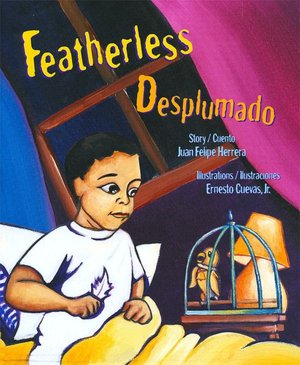I LOVED this book! Not only does it portray Tomasito positively in every way possible, it is beautifully written and vividly illustrated. Here's the evaluation:

Category
|
Related Information
|
Comments
|
Name
of Book:
|
Featherless
Desplumado
|
|
Author
|
Juan
Felipe Herrera
|
|
Illustrator
|
Ernesto
Cuevas, Jr.
|
|
Publisher
|
Children’s
Book Press/Editorial Libros para Ninos
|
|
Year
of Pub:
|
2004
|
|
ISBN:
|
0-89239-195-2
|
|
Age
range
|
4-10
(or even older)
|
|
Type
of Disability
|
Spina
bifida
|
|
Fiction
or Nonfiction
|
Fiction
|
|
Category: B
A) books that provide factual
information about a disability
B) books that provide information
about a disability in a story format in which the character with a disability
is integral to the plot
C) books that provide stories that
have a character with a disability who may or may not be integral to the
storyline and who has been added to the story to achieve diversity and
reflect reality
(Categories borrowed from J.K. Blaska's book Using Children's Literature to Learn About Disabilities & Illnesses: For Parents and Professionals Working With Young Children, 2nd ed.; 2003; Educators International Press, Inc. Troy, NY) |
||
Annotation
Tomasito
has just moved to another town with his Papi and wants to fit in and play
soccer with the other kids, not an easy task when you’re in a wheelchair. Tomasito
wishes he didn’t have to answer all the questions about why he cannot walk.
When Papi brings Tomasito a little bird with a curled-up leg and no feathers,
Tomasito feels bad that the bird can’t fly. But with a little encouragement
from Papi and a girl at school, Tomasito finds a way to help himself and his
bird. “There’s more than one way to fly!” he concludes. Written in English
and Spanish.
|
||
Links
to professional reviews
|
||
Standards for Quality Portrayal
of Characters with a disability
|
Comments
|
|
1.
Promotes empathy not pity
|
Yes
|
|
2.
Promotes acceptance, not ridicule
|
Yes
|
|
3.
Emphasizes success rather than, or in addition to failure
|
Yes
|
|
4.
Promotes positive images of persons with disabilities or illness
|
Yes
|
|
5.
Assists children in gaining accurate understanding of the disability or
illness
|
Yes
|
Good
explanation of spina bifida at the end of the book.
|
6.
Demonstrates respect for persons with disabilities or illness
|
Yes
|
|
7.
Promotes attitude of “one of us” not
“one of them.”
|
Yes
|
|
8.
Uses people-first language
|
Yes
|
People-first
and poetic!
|
9.
Describes the disability or person with disabilities or illness as realistic
(not subhuman or superhuman)
|
Yes
|
|
10.
Depicts people with disabilities as more similar to than different from other
people
|
Yes
|
|
11.
Shows peoples’ strengths and abilities along with their disabilities
|
Yes
|
|
12.
Represents characters as strong, independent people who others can admire or
learn from
|
Yes
|
|
13.
Represents people with disabilities from different racial and cultural
backgrounds, religions, age groups, and sexual orientations
|
Yes
|
Main
character is Hispanic.
|
14.
Shows people with disabilities in integrated settings and activities
|
Yes
|
|
15.
Shows people with disabilities in valued occupations and diverse roles.
|
Yes
|
|
16.
Shows people with disabilities in reciprocal relationships
|
Yes
|
|
17.
Main character develops and grows emotionally as a result of what happens in
the story
|
Yes
|
|
Holly, thank you so much for sharing this blog. It is great! I reall think the books would be a great resource for parents as well as teacher’s. Skimming over several of the books, it seems as though a lot of these books would also be helpful for students who face the day to day challenges. I am particularly interested in reading, Keep Your Ear On the Ball.
ReplyDeleteKelly Lachance